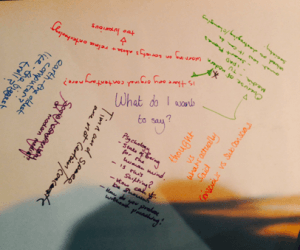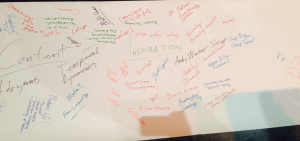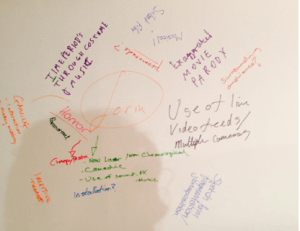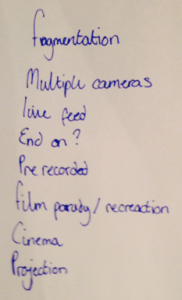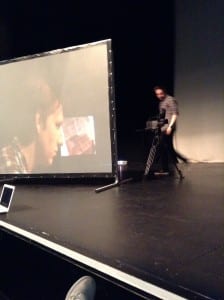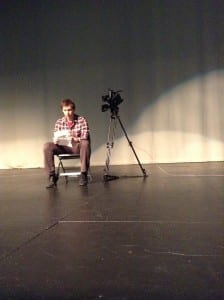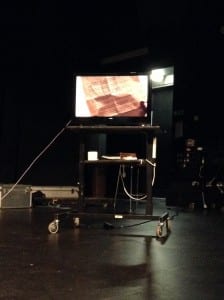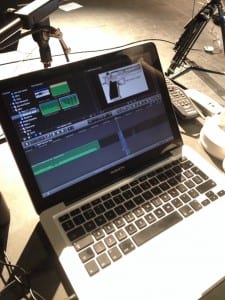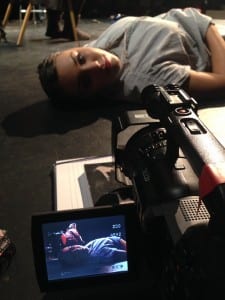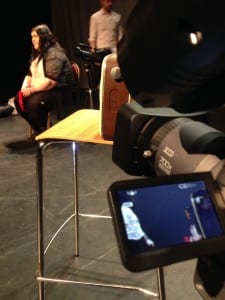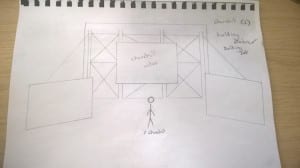Devising begins
The teaching had subsided and this week was the beginning of our devising process. A helpful starting point for this process was to create a visual diagram of ideas and inspirations which would give everyone the opportunity to get their ideas and their preferences heard. The three main headings for the diagram included; Form, Content and Inspirations.The diagram not only meant we could all write down our ideas but also read everyone else’s. We all wrote what we wanted then walked around the paper to see what direction other people wanted to go in, some people were even inspired what others had wrote which sparked new ideas amongst the class.
Once everyone had written a substantial amount, we had to narrow the ideas down. We did this by identifying similar ideas, common interest and the most popular themes.
These included:
-Fragmentation
-Multiple cameras
-Live feed
– Pre recorded footage
– CCTV
– Re creating/Re enacting
140 characters or less
No introduction, no context, just words.
These 140 characters inhabit power. The sort of power that can make someone I have never met before from the other side of the world, know how my day is going my simply reading my twitter feed.
I can write whatever I want (in 140 characters or less) and anyone from anywhere in the world can respond to their desire.
Even with its limited text output, Twitter enables the possibility for a global platform.
Just 140 characters thrown together to create words, in a particular order that makes our brains say “yes I understand that”. These words typed in a specific way so that when it is read, it is recognized, like a specific code or language.
People who read my tweets last week were completely unaware of the task I was given but because I wrote it in a recognizable form, people responded. The use of hashtags in each tweet gave the tweets connections and something for my followers to actually follow.
I had followers who were, and I quote, “gripped” by it. I gained ‘retweets’, ‘favourites’, ‘followers’; a social media recognition and appreciation.
People I haven’t seen or spoke to face to face in years are interested in something I am typing which has nothing to do with them, has no relevance to them and probably doesn’t make much sense to them, all because It just so happens to catch their eye as they scroll aimlessly through their Twitter feed. They feel compelled to respond to it and engage with it.
That’s incredibly powerful and yet so easily done.
To incorporate this into our piece creates an experience for the viewer, it demands responsive engagement from them. It enables a co-authorship of the piece and would be just as much of an experience for us, the performers, as it would for the audience.
I think that using twitter in our performance, and giving the audience some agency through this social media, could potentially create something that both incorporates modern day technology to benefit and improve theatre as well as exposing this type of technology as potentially hazardous to modern theatre.
Fragmentation
The process we are in at the moment seems a bit playful and unstructured as we are not necessarily learning lines or blocking scenes but it is useful and important all the same.
By purely experimenting with materials produced, such as short scenes or a monologue, even an idea with the camera, we are slowly but surely making progress.
The beauty of producing a fragmented show enables you to play around with different ideas and themes. Things we experiment with in these sessions can all be brought forward into the final show; we can alter them and expand on them to produce something with meaning and of worth. Cutting and stitching pieces together is what will make our show. It has been and will be of worth to discuss what works and how we could expand what works to start producing full scenes.
Reservoir Dogs
We were given the task of splitting off into groups and choosing a 5 minute scene from a film. We then had to recreate this scene on the stage, using the multimedia technology.
I immediately thought of the ear cutting scene in Quentin Tarantino’s Reservoir Dogs. The scene shows character, Mr Blonde, toying with a hostage and then taking a razor blade to his ear and cutting it off.
“Classic Quentin: Reservoir Dogs “Ear Scene” HD”:
The scene primarily takes place in one room, except for when Mr Blonde leaves that room to go to his car. We staged this by having a live feed camera following Mr Blonde (Me) off stage but with the camera on my face the whole time. We chose to present it this way because it builds up tension in the scene; the main character has left the stage, there is a live feed of the main character but the audience cannot see where the main character is going, the music is still playing and the other characters are left on stage.
When it came to the ear cutting scene, Tarantino chose an angle that didn’t explicitly show the ear being cut off as Mr Blonde was sat on the hostage so his body covered the guys face. When we were on stage that is the same view the audience would receive so we wanted to create a new shot for the audience with a camera.
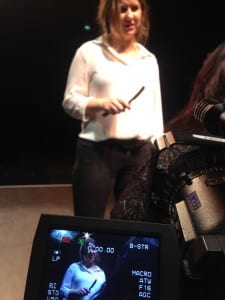
What is performance?
Something that caused difference of opinion amongst the group was the distinction between theatre and performance. I noticed a few people in the group found it difficult to grasp that we could create a performance that wasn’t theatre or naturalist theatre more specifically. During our process we spent most of our time struggling with a concept and I think it was because of the lack of clarity between the two terms, theatre and performance. Richard Schechner claims performance can be everything from everyday life, to sports, to a play performed in a theatre. So what we were creating wasn’t necessarily theatre but it was definitely performance. The idea of the piece being a play held us back a lot, we felt restricted and conformed. When we let go of those restraints, we had a lot more freedom. We felt that even playing around with audio, camera feeds and live bodies in the space was still productive and could potentially be developed into a scene.
A particular favourite of mine
I had one scene in particular which was my favourite; The Wright Brothers scene. Not only was the scene visually and aurally beautiful but it also stood out to me because of its simplicity. In that 7 (or so) minute scene, no text was spoken, no narrative spelled out, no extravagant props or set. Just two guys with paper and the cameras were there to simply observe.
The Wright Brothers invented the very first successful aeroplane and enabled society to fly across the world. This scene represents a world changing moment in history and could have been overloaded with text, action, narration, audio and video merely because of its huge significance in history. At one point, this scene was just that; overloaded but after receiving feedback, we realised the scene could be beautiful stripped back. We didn’t need the action of two characters building a plane or elaborate props or set. We loved the idea of using paper to show who the two guys on stage were portraying; Connor used the paper to draw designs and parts of planes and Jake used the paper to construct paper planes.
As the scene was focused on planes and the piece itself was looking at moments in history that changed the way the world works, we felt there should be a connection to 9/11. We wanted it to be subtle and simple because there was no possible way we could re create such a horrific event on stage. We decided to use the actual audio of a voicemail message made from a flight attendant on the plane, CeeCee Lyles.
9/11. United Airlines Flight 93. Phone call made by CeeCee Lyles:
The music used in the scene was by composer Claude Debussy, as his music fit in with the time period and also was very peaceful and did not take away from the action on stage; only complimented it.
Claude Debussy – Nocturne
Stripping back
When in the midst of the rehearsal process it is sometimes difficult to indentify problem areas. At this point, the focus was working on the individual scenes and their content. Even when doing a full run of all the scenes, it can still be difficult to see the piece as an impartial spectator. Fortunately for us, Wes was a regular visitor and was happy to offer plenty of constructive criticism and feedback. There was one piece of feedback that had the most effect; it completely changed some scenes until they were a brand new scene entirely. The feedback was to strip everything back. We were overloading every scene with bodies in the space, props, lots of different action happening at the same time and also an overload of tech. I think we did this because there was a growing concern that our audience were potentially of limited historical knowledge, as some of the scenes were re creating moments in history that, unless you are historically apt, might not be as well known as others. Another reason we did this was because of the lack of a continuous narrative throughout the piece, without the narrative it felt as though we needed to cram everything we knew and everything we explored about each scene into each scene. The perfect example of this was the suffragette scene. At first the scene was packed with all different aspects and ideas of feminism, the female form, the suffragette movement, modern women and iconic women. We had multiple performers on stage, all representing feminism and what surrounds feminism. But after being given feedback, we realised that there was too much going on and it was unclear what the scene was trying to say. The final scene was very simple and minimal yet depicted the pain and suffering women went through n order to gain equal rights.
Another thing we were concerned with was our use of tech, a question which continuously cropped up in rehearsals was; what is the multimedia aspect in this scene? This question caused us to overdose on the use of technology in every single scene, which we didn’t need in order to achieve a multimedia performance. We kept forgetting that what comes after that question is; what is the reason behind using this technology here? We encountered a similar problem at the very beginning of the devising process when we explore the idea of G.O.D. The Government of Development was a fictitious government with excessive control and surveillance over its citizens. This idea was conjured up because a lot of discussion was based around being watched, the invasion of privacy and society being a mass mediated and mass technological one. I was particularly unconvinced with the idea. The more we discussed ideas of content and writing, the more I disliked it. It felt as though we were overdosing on the concept of multimedia technology, as it was already being used in a formal sense, why did the idea need to be presented in content too? The fact the our performance would have multiple different types of mediated technology on stage and off stage, as functions of the performance, it felt too much to have it as the content of our piece too.
Precise intention
Something that was pointed out to me and Rory, as directors, was the overall aesthetic of the piece and style or performance needed solidifying. With this feedback, we were also told to look at different work and gather inspiration for how we wanted our performers to be on stage. As an ensemble, we decided we wanted our performers to be very precise, very intentional and precise with their movements. We looked at Robert Wilson’s work and were inspired by how his performers carry themselves and how his performers look as an ensemble.
The Life and Death of Marina Abramovic III:
We gave the instruction that no one was to move unless they had to and every movement was to be thought out before actually moving. We used this to performance style when approaching scene transitions. Rory and I decided that due to the vast amounts of tech on stage and constant set changes for each scene, there was no point in trying to disguise what was happening during a transition. The piece was already quite clearly fragmented and non linear, therefore there was no need to disguise this construction of different worlds for each scene. So we approached it as though they were mini scenes themselves. Everyone was given a role during each transition and we asked everyone to enter the stage space with a very slow paced walk, head held high and posture upright. When picking up objects and equipment, it was to be done slowly, neatly and precisely then moved to its next position. We felt that by doing this, it re enforced the idea that our performance was being constructed before our audience and they were witnessing how we were constructing it.
The performance style altered slightly during each scene, for instance during scenes with naturalism the performers were to perform in a naturalistic manner. The suffragette scene was a scene that needed choreographed, precise and intentional movement. The scene involved Georgie watching a looped video of suffragette Emily Davison jumping in front of the Kings horse at the Epsom Derby and then attempting to replicate Emily Davison’s movements.
http://www.infinitelooper.com/?v=um9GV6_AILM&p=n#/120;1377
We wanted the movements to be choreographed and repetitive, like a dance routine. We watched Pina Bausch’s Café Müller to gain inspiration for movement, in particular the pair scene;
Pina – pair scene from Café Müller:
We instructed Georgie to use this sequence when creating her movements. Along with the onstage action, an audio track played. The track was a compilation of women speakers, leaders and activists all of whom have had impact on feminism or equal rights.
The looped video, the action from the performer (Georgie) and the audio track all combined created an emotive and powerful scene.
Final Performance
It was hard to believe that the day had arrived. After months of struggling with devising a concept and creating a full production; it was show day. With a mass mediated production such as ours, there was bound to be set backs or issues on the day and that was something we didn’t escape from. Lighting was our first major issue, on paper they looked great and we imagined the designs would illuminate the stage beautifully however that was not the case when we ran our first rehearsal in the space on show day. There were issues with light bouncing off projectors and light not reaching performers bodies, it seemed almost impossible to find the perfect lighting so had to settle for a happy medium between reaching the performers in the space as well as not effecting the two projections on both sides of the stage.
Here is a sketch, drawn by cherry, of the stage and how it was set up. This particular sketch was drawn up for one of the early stagings of the Churchill scene.
Watching the final performance was a nerve wracking experience, I felt so out of control and useless. Again, due to this mass amounts of tech and endless lighting, audio and video cues, there were issues but this time during the performance. During the Churchill scene, a camera was brought on stage without a fresh battery thus losing a shot of one of the performers and then another camera failed to work during the Freddie scene. These issues are unpredictable and cannot always be prevented however there were a few moments that I felt could have been prevented by better communication between myself and the cast. There were moments that I was certain I had directed a certain way and yet it was not being performed that way, this made me reflect on my communication within rehearsals.
Overall, I was very pleased with our performance and so proud that after all the hard work, the time and effort we put in we had put on a beautiful show.
Devising begins – form image, what do i want to say image, inspo image, fragmentation image
140 char – twitter 1, twitter 2, twitter 3
Fragmentation – sam image, proj image, paper tv image
Reservoir dogs – ear scene vid, gun image, razor image, poppy image, razor 2 image?
What is performance? – Richard Schechner – performance studies: an introduction
A part
Works Cited
EUcitixenLT (2009) 9/11. United Airlines Flight 93. Phone call made by CeeCee Lyles. [online video] Available from: https://www.youtube.com/watch?v=2bnPmyUUEjg
DesAbends (2009) Debussy: Nocturne (1892) [online video] Available from: https://www.youtube.com/watch?v=uyZJ3rNb4xM
ReservoirWatchDogs.com official YouTube Channel (2011) Classic Quentin: Reservoir Dogs “Ear Scene” HD [online video] Available from: https://www.youtube.com/watch?v=ye7x3jbi_TE
Paul Cuthbert (2011) The Life and Death of Marina Abramovic III [online video] Available from: https://www.youtube.com/watch?v=MWgD9ZEdZA0
Schechner, R. (2002) Performance Studies: An Introduction. New York: Routledge.
Hedvika Kadlecova (2014) Pina – pair scene from Cafe Muller [online video] Available from: https://www.youtube.com/watch?v=VCQ29EUwvrI
InfiniteLooper (2015) Infinite Looper: Easily loop your videos. [online] California: InfiniteLooper. Available from: http://www.infinitelooper.com/?v=um9GV6_AILM&p=n#/120;204

